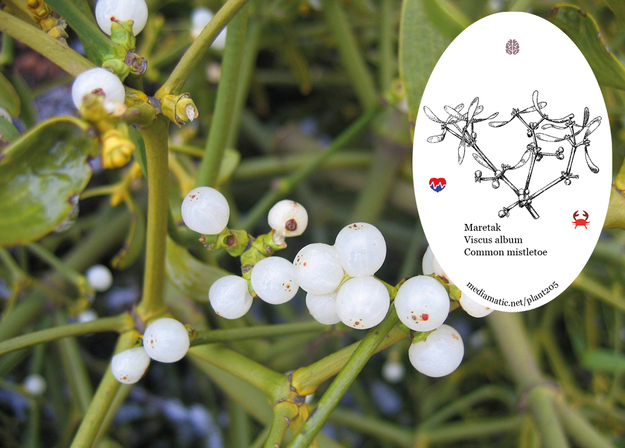Mistletoe is chiefly used to lower blood pressure and heart rate, ease anxiety and promote sleep. In low doses it can also relieve panic attacks and headaches, and also improves the ability to concentrate. The plant's efficacy as an anticancer treatment has been subject to a significant amount of research - there is no doubt that certain constituents of the plant , especially the viscotoxins, exhibit an anticancer activity but the value of the whole plant in cancer treatment is not fully accepted. It is said that the constituents of mistletoe vary according to the host plant it is growing on - that found on oak trees is said to be superior. Because of the potential side effects, this plant should only be used internally under the guidance of a skilled practitioner. Using the plant internally can provoke intolerant reactions to certain substances. The leaves and young twigs contain several medically active compounds. They are antispasmodic, cardiac, cytostatic, diuretic, hypotensive, narcotic, nervine, stimulant, tonic and vasodilator. They are harvested just before the berries form and are dried for later use. Mistletoe has a reputation for curing epilepsy and other convulsive nervous disorders. The effect of the correct dosage is to lessen and temporarily benumb the nervous activity that causes the spasms, but larger doses can produce the problem. Mistletoe has also been employed in checking internal haemorrhages, in treating high blood pressure and in treating cancer of the stomach, lungs and ovaries. Externally, the plant has been used to treat arthritis, rheumatism, chilblains, leg ulcers and varicose veins. A homeopathic remedy is made from equal quantities of the berries and leaves. It is difficult to make because of the viscidity of the sap. The German Commission E Monographs, a therapeutic guide to herbal medicine, approve Viscum album Mistletoe for rheumatism, tremor therapy as a adjuvant (see for critics of commission E). Source: https://pfaf.org/
Common mistletoe
Viscum album
Find more about this plant on Wikipedia.
